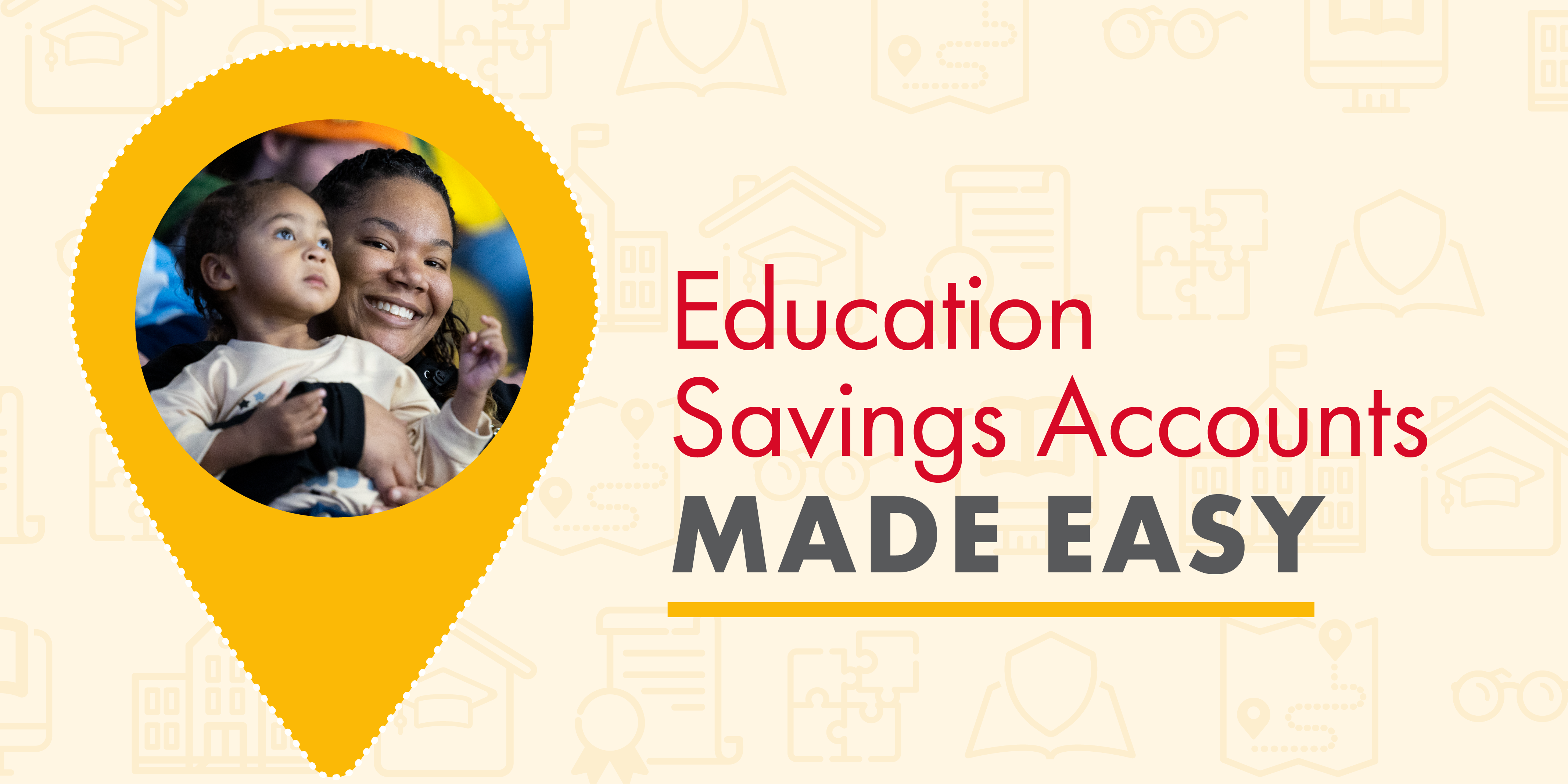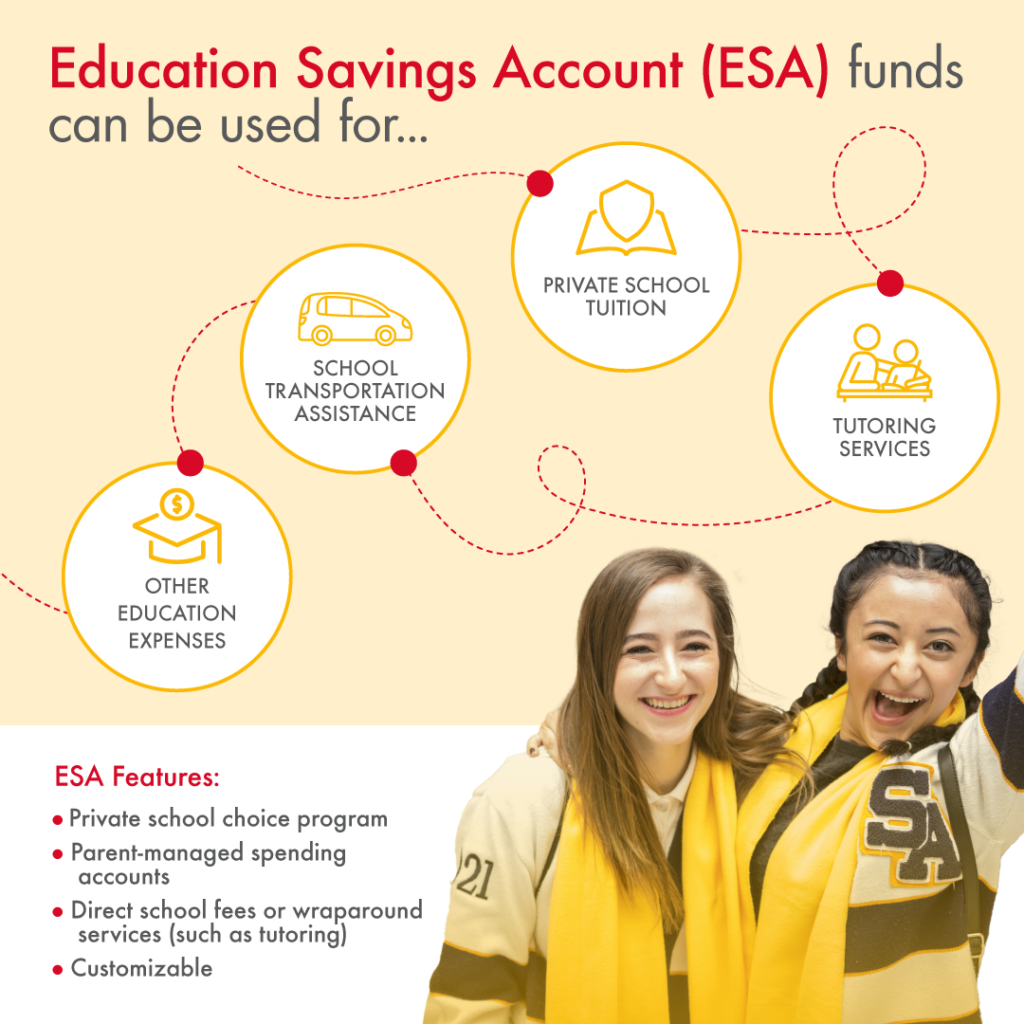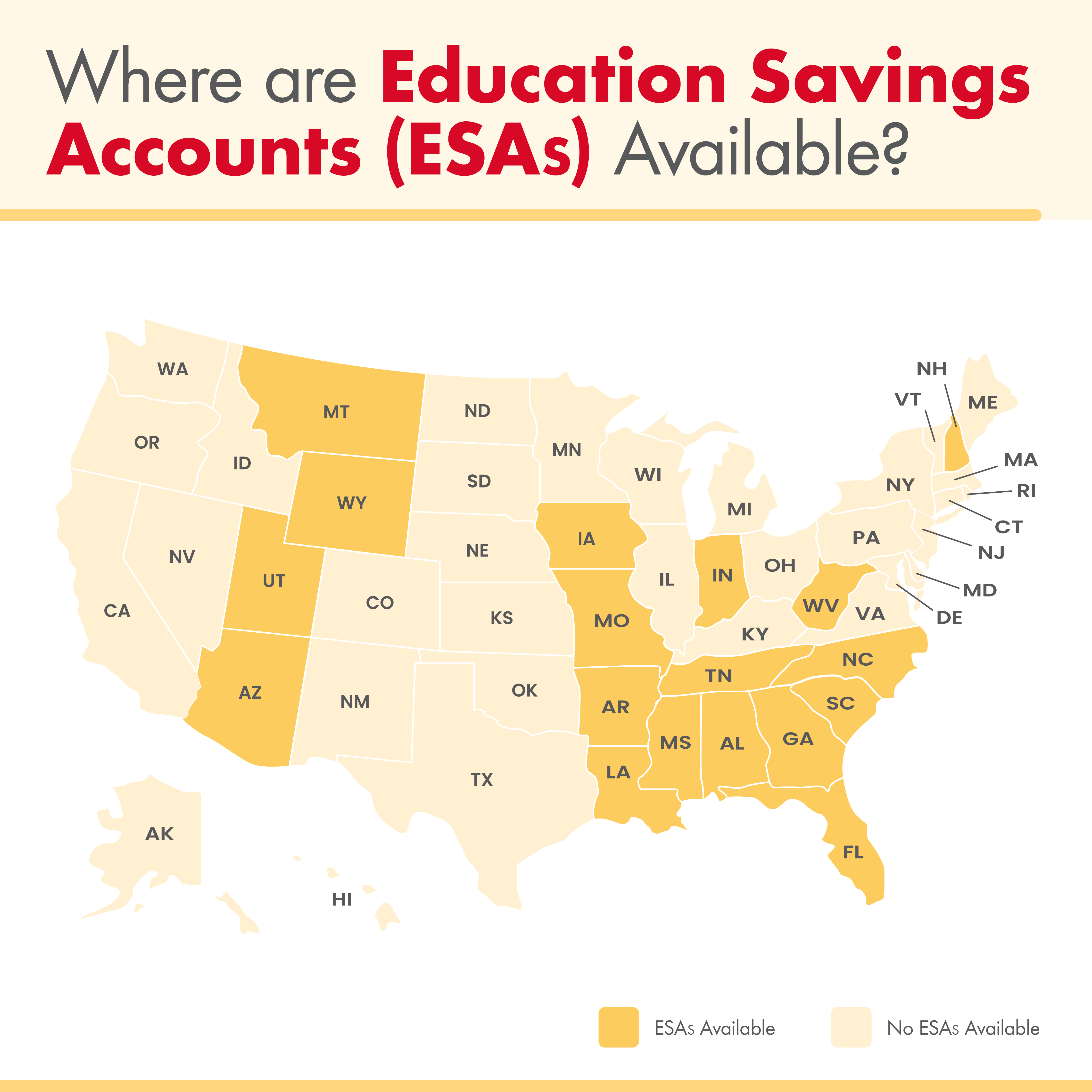Posted on Modified on Posted by National School Choice Week Team
Education Savings Accounts (ESAs) Made Easy

“ESAs are private school choice programs in which parents are given access to funds to pay for approved educational expenses. This allows them to choose and customize an education that best fits their child’s needs.”
Education Freedom Account, Education Scholarship Account, and Empowerment Scholarship Account—these variations of names reflect a growing type of school choice emerging across the country.
Education is transforming, and families nationwide are exploring ways to personalize their children’s learning to fit their lifestyles. This is where education savings accounts (ESAs) come into play. ESAs are a valuable tool that can greatly impact your child’s educational journey. Whether you’re a parent planning for your child’s K–12 education or brainstorming ways to enrich your homeschooled child’s extracurriculars, ESAs can be a game changer in your education journey.
These programs are becoming more popular nationwide, with over 982,000 families gaining access to this type of program for their children. Because ESAs are designed to be customizable and reflect unique educational decisions for families, they can be complicated and, at times, confusing to the uninitiated. However, that flexibility offers huge benefits to families who want to choose not just a single private school, or independent homeschooling, but a full toolbox of education services with their ESA. A community of parents who have navigated these waters and can offer their insights as you unpack what this might mean for your family is developing.
Throughout this guide, we will highlight ESAs, their functions, and their usage in various school sectors, including private school, online learning, homeschooling, and microschooling, emphasizing their flexibility and the opportunities they offer. We hope this guide will be the compass for unlocking new paths in your child’s academic journey by giving your family the flexibility to choose.
What is an education savings account?

An ESA is a type of funding that helps fund a student’s K–12 education, much like a scholarship. What sets an ESA apart is its flexibility. In addition to paying for private school tuition, an ESA can also pay for other expenses, such as tutoring fees, college placement exams, after-school education programs, and more.
Programs like these have been around in Arizona and Florida since the early 2010s, but a recent crop of new or expanded programs, which are open to all or nearly all students in the state, has put them in the national spotlight.
Under these programs, the funding does not come from parents’ pockets but from the funds that state governments have allocated for each child’s education. Rather than being assigned to a traditional public school that may not suit their needs, families can use the funds to choose a school or education provider that they believe will best meet their children’s needs. This flexibility allows parents to customize their children’s education to match their unique interests and learning styles.
Tax-credit education savings account
Tax-credit ESAs are a unique type of savings account that allows taxpayers or businesses to receive a tax credit when they donate funds to nonprofit groups that manage and fund parent-directed ESAs. Currently, three states offer tax-credit ESAs: Alabama, Florida, and Missouri.
How do ESAs work?
Each state has its own set of rules for determining which students are eligible for their ESA program and the amount of funding they can receive. Additionally, each state has its administration system in place for the program, including identifying the various types of services that can be purchased with ESA funds and deciding whether the state or a third-party organization will manage the program. Despite these differences, the basic operation of the program remains similar nationwide.
Eligibility
Eligibility requirements for ESAs differ from state to state. In general, eligibility criteria are based on factors such as:
- Age
- Residency
- Income status
- School enrollment status
- Special needs (IEP and IDEA status)
Students usually need to be residents of the state offering the ESA program to be eligible. The coverage of these programs typically spans kindergarten through 12th grade, with some newer programs including pre-K as well. Some programs are only available for low- or middle-income families, while others have no income restrictions and are becoming increasingly popular. In fact, there are currently seven states (Alabama, Arizona, Arkansas, Florida, Iowa, Utah, and West Virginia) that have enacted universal ESAs, which means that every student, regardless of income, can apply. However, it’s good to note that universal eligibility has not yet phased in.
Enrollment in a public school with specific performance ratings or having an individualized education plan (IEP) in place may also determine eligibility. Particular programs cater specifically to students with disabilities or special needs. For instance, Florida, Mississippi, North Carolina, and Montana have ESAs specifically for students with special needs that can be used for expenses such as speech pathologists and therapeutic uses.
Students who participate in the ESA program, whether they choose a private school, homeschooling, online learning, or microschooling, may need to complete a standardized assessment, a nationally norm-referenced achievement test, or a nationally recognized aptitude assessment. However, some states, such as Arizona, do not require students to complete these exams. Students with disabilities may also be exempt from taking them. To learn more about eligibility and exemption criteria, you can contact your state’s Department of Education for clarification.
What is the process of applying for an Education Savings Account (ESA) program?
Gathering the right documents
Applying for a K–12 ESA can be a challenging process. Before starting the application process, it’s important to gather the necessary documents and materials. These documents typically include proof of residency, proof of income, and proof of identity. Collecting these documents beforehand can streamline the application process and make it easier for you to complete the application.
Completing the application form
Once you have collected the required documents, you can proceed to fill out the application form. This form will typically require personal information about the parent or guardian and the student. For example, you may be asked to provide proof of exams, proof of enrollment in a failing school, and other necessary details. ESA applications can be done either by mail or online, depending on the state’s rules. It’s important to keep track of the application window and deadline to ensure that you submit your application on time.
Approval or Denial
Okay, so you submitted your application and are now waiting for its approval or denial. If the application is approved, you will receive notice from the ESA provider, and funds will usually be available within 30 days after approval. Some applications may take longer to process if they require extra documents that must be reviewed manually. If the application is denied, you will receive a notice from the ESA provider explaining the reason for the denial. It’s good to know that you may have the option of appealing the denial if you disagree.
Manage, monitor, and maintain
If your application for an ESA has been approved, you can now use it to fund education-related expenses. It is crucial to keep a close eye on your child’s ESA account to ensure that you accurately track both contributions and expenses. Additionally, it is important to stay informed about any changes or updates to ESA regulations that may affect your account or eligibility.
What are the eligible expenses?
So, what expenses can families use ESA programs for? Here are the most commonly approved expenses, though keep in mind that each state has different criteria for approved expenses:
- Tuition and fees at a participating school
- Textbooks
- Fees for after-school or summer education programs at a participating school
- Private tutoring
- Curricula
- Tuition for a nonpublic online learning program
- Educational software
- Costs for college admission tests and AP exams
- Education services for students with disabilities from a licensed or accredited practitioner
- Contracted services provided by a public school district
Are you interested in learning about the various ways in which parents utilize the benefits of ESAs to fulfill their unique needs? Below, you will find some innovative examples of how parents leverage ESAs.
How do families use ESAs?
With ESAs, parents can fund extracurricular activities, purchase specialized educational resources, and customize their children’s learning experiences. Based on feedback from families utilizing ESAs, we have compiled fictionalized stories showcasing the creative ways in which they have used them.
Lisa, a parent who is teaching her kindergartner at home, shared that the ESA program in Arizona had been really helpful for her. Through the program, she was able to purchase educational items, such as a small robot that teaches coding and a kit to build a Hot Wheels track to test out different speeds and velocities.
Jessica is a Mesa parent with five children between the ages of 6 and 18, all of whom use ESAs. To fulfill their physical education requirements, they are all enrolled in soccer. Thanks to the flexibility provided by ESAs, Jessica purchased a book on the chemical reactions involved in cooking for another son interested in culinary arts.
Lexi, an 8th grader from Utah, has recently started struggling with math concepts and is falling behind in her class. Concerned about her academic performance, Lexi’s mom has decided to use ESA funds to enroll her in a specialized math tutoring program offered by a licensed professional at a local public school
In certain states, special boards or program administrators can approve education-related purchases that are not on the approved list. Teachers, school administrators, or education providers can submit a request for approval of a product or service that is not pre-approved. If necessary and aligned with educational goals, the purchase may be approved. This process allows schools to adapt to changing needs while ensuring reasonable and beneficial purchases.
ESA’s and Homeschooling
With more than 5% of U.S. students homeschooling nationwide, ESAs have emerged as game changers for homeschooling families, offering flexibility and resources. With ESAs, homeschooling parents gain access to funds that can be used for a wide range of educational expenses, empowering them to tailor their children’s education to suit their unique needs and preferences.
One significant way ESAs impact homeschooling is by providing financial support. Homeschooling often requires investment in many resources, such as curriculum materials, educational tools, and extracurricular activities. Parents can also use ESA funds to access specialized courses, online learning platforms, tutoring services, and even educational experiences outside the home. This flexibility enables parents to create a well-rounded and engaging curriculum that meets their children’s individual learning needs and interests.
Numerous states nationwide currently allow homeschoolers to participate in ESA programs. However, it is important to note that these states have additional requirements for homeschooling families who want to participate in ESA programs. Arizona, Arkansas, Utah, Wyoming, Missouri, New Hampshire, West Virginia, and Florida allow families to participate in ESAs while continuing homeschooling. In New Hampshire, Florida, and Utah, families are required to opt out of their homeschool status, but they can continue home-based learning. West Virginia homeschooling families are eligible for the ESA program if they enroll their child in public school for a minimum of 45 days. Wyoming’s newly established ESA program will allow home-based learners to take part. Arkansas ESA is gradually opening up eligibility for homeschoolers by 2025.
Long-time homeschoolers caution those considering using an ESA to support their family’s homeschooling to think carefully about the tradeoffs. State funding through ESAs comes with greater oversight of homeschooling families and more regulations. For families considering homeschooling for the first time, it’s worth speaking with veteran homeschoolers you know, or a state homeschooling support organization, to learn more about the pros and cons.
Future for ESAs and Microschooling
In the future, ESAs are likely to become increasingly popular as more parents seek greater control over their children’s education and look for more options. Already, 10–15% of ESA users nationally opt for a custom approach to its usage rather than just using it as a voucher. While ESAs provide families with funds and the flexibility to personalize through providing access to educational expenses, microschooling opens up an even newer possibility of further personalizing their children’s educational journey. Over a million families nationwide are participating in microschooling.
In some states, the implementation of universal ESA programs has led to an increase in microschooling. This involves small groups of families pooling their resources to purchase a curriculum or enroll in a hybrid school option. While students may primarily learn at home from their parents, they can take one or two courses from a microschool, an online program, or even a public or private school. ESA accounts could fund the a la carte course costs.
Together, ESAs and microschooling represent a shift toward a personalized approach to education. As these educational alternatives continue to gain traction, they have the potential to completely reshape the educational landscape and provide more options for families.
Where Are ESAs Available?
Alabama (Soon to be universal)
Starting in the 2025–2026 school year, the CHOOSE (Creating Hope & Opportunity for Our Students’ Education) Act will provide eligible families (students from families with incomes up to 300% of the federal poverty level) with a tax-credit ESA worth $7,000 per student. This amount can be used to cover eligible education expenses.
Arizona (Universal)
Arizona’s Empowerment Scholarship Accounts program has been expanded to include all students in the state. The program provides scholarships averaging around $7,000 to families enrolled in the program. As of 2024, approximately 9.8% of Arizona students are participating in this widespread program.
Arkansas (Soon to be universal)
The Arkansas Children’s Educational Freedom Accounts program has been launched to help families afford nonpublic learning options. Participants can receive 90% of their children’s state education funding (around $6,600 in 2023–24) deposited into an online account for approved expenses, such as private school tuition. Eligibility for the program in 2024–25 includes students with disabilities, homeless and foster students, first-time kindergarteners, current Succeed Scholarship recipients, children of military personnel and veterans, first responders, and students from D- or F-rated public schools or Level 5 Intensive Support School districts. By 2025, eligibility for the program will extend to all Arkansas students.
Florida (Universal)
In 2023, Florida expanded its state-run programs to support families opting for private education. The existing Family Empowerment Scholarship Educational Opportunity Voucher program and Florida Tax Credit program have transitioned into ESA programs. These programs are available to all children in the state seeking nonpublic school options. Participating families receive education funds—approximately $8,000—deposited into an online account.
All families are eligible to participate, but low-income households and foster care children receive first priority, followed by middle-income households.
Students with IEPs, struggling readers, and victims of bullying can also apply for Florida’s Family Empowerment Scholarship for Unique Abilities. To help eliminate a waitlist for students with special needs, Florida expanded its Family Empowerment Scholarship for Students with Unique Abilities Program in 2023. Scholarships were extended to families with pre-K students in 2024, and the enrollment cap was raised to more than 72,000.
Georgia
Starting in 2025, eligible students (those enrolled in the bottom 25% of public schools and those whose families earn less than 400% of the federal poverty line) can apply for Georgia’s newly created Georgia Promise Scholarship, which will award up to $6,500 in an online savings account for approved education expenses.
Indiana
Indiana’s Education Scholarship Account program provides ESAs to eligible families to cover the cost of private school tuition for their children. The program permits parents to use state funds to pay tuition at participating private schools. Eligibility for the program is primarily based on income (no more than 400% of the federal poverty level) and other criteria, such as attending a public school with a D or F rating or having a sibling already using an ESA.
Iowa (Soon to be universal)
Iowa has an ESA program that provides funds to families for tuition and other expenses at accredited private schools. In the 2023–2024 school year, more than 18,000 students participated in the program. For 2024–2025, students who used Iowa’s ESA program last year, current public school students, and new kindergarteners can apply for the program, regardless of their income. Additionally, current private school students from families whose income is less than or equal to 400% of the federal poverty level are now eligible. This means that about 94% of students in the state will be eligible for the program this school year!
Mississippi
The Mississippi ESA program, also known as the Equal Opportunity for Students with Special Needs program, offers students with IEPs a chance to obtain a portion of their public education funding in a savings account. The program’s goal is to empower families of students with special needs by providing them with more educational options and resources tailored to their children’s individual requirements.
Missouri
In 2024, the MOScholars ESA program in Missouri expanded statewide. This program offers flexible scholarship funds that families can use to attend eligible public, charter, virtual, private, or homeschooling. Additionally, families can use the funds for educational therapy or school transportation. To qualify for this program, students must have an IEP or be from families earning up to 300% of the federal free-and-reduced-price lunch program.
Montana
Montana will be launching a new ESA scholarship this year, specifically intended for students with special needs. Families who choose to participate in this scholarship program will be provided with an online account that will receive approximately $6,800 in funds for their children’s education.
New Hampshire
New Hampshire has implemented an ESA called the “Education Freedom Account” program. The program offers ESAs to students from low- and middle-income households, allowing them to personalize their learning experiences. In 2023, eligibility for the program was extended to students from households with incomes less than 350% of the federal poverty level, which was $105,000 for a family of four. Currently, the program has over 4,000 children participating in it.
North Carolina
The Personal Education Student Account for Children with Disabilities program in North Carolina provides families of students with special needs an account that offers funds for educational and therapeutic purposes. The maximum yearly allocation is $9,000, but students with specific disabilities can receive up to $17,000. To be eligible, the student must meet the federal definition of a child with disabilities under the Individuals with Disabilities Education Act.
South Carolina
South Carolina’s Education Scholarship Trust Fund Program will provide families with an ESA for private school tuition and other educational expenses. The scholarship is designed to phase in over the course of three years. In the first year, it will be available to 5,000 low-income students whose household income doesn’t exceed 200% of the federal poverty guidelines. To be eligible for the scholarship, a student must have attended public school the previous year or be a first-time kindergartner.
The scholarship program will expand in 2025–2026 to become available to up to 10,000 students whose families have an income of up to three times the federal poverty level. By 2026–2027, families with an income of up to four times the federal poverty level can apply, and as many as 15,000 students can receive scholarships.
Tennessee
Students residing in Chattanooga, Memphis, and Nashville can participate in the Tennessee ESA program. The program is open to those who are either transferring from a public district or charter school or are eligible for first-time enrollment in a Tennessee school. Private school students can also take advantage of the program by using the funds for various K–12 and higher education expenses, including tuition and fees.
Program eligibility is limited to:
- Students who are entering kindergarten or will be in 1st through 12th grade and are zoned to attend public schools in Memphis (Shelby County) and Nashville;
- Students who are enrolling in Tennessee schools for the first time or who attended Tennessee public school for a full school year last year; and
- Students who live in a household that receives Temporary Assistance for Needy Families (TANF), are homeless, and live in a household with an income that does not exceed twice the federal income eligibility guidelines for free lunch. (For example, a student in a family of four with an income of $36,075 qualifies for free lunch; a student in a family of four with an income double that amount, $72,150, qualifies for the ESA).
Tennessee also offers the Individualized Education Account program, which provides families of students with special needs an account that offers funds for educational and therapeutic purposes. To be eligible, the student must have an IEP.
Utah (Universal)
The Utah Fits All Scholarship program provides families with $8,000 to cover the cost of nonpublic school options, such as private schools. In addition to private school tuition, families can use the funds for personalized learning needs, which include tutoring services, educational software, individual classes at public schools, or dual enrollment at technical colleges.
The Utah Fits All Scholarship offers partial scholarships to students who enroll part-time at their public school. For instance, a student might be able to enroll in specific courses at his or her neighborhood school while still receiving $4,000 for nonpublic education expenses.
Utah Fits All Scholarships are also available to homeschool students! Participation in the program requires following its guidelines and rules. Students who receive scholarships must submit a portfolio every year that describes their educational opportunities.
West Virginia (Soon to be universal)
In 2021, the state of West Virginia implemented the Hope Scholarship program, allowing students who are currently enrolled in public schools or preparing to start kindergarten to use their education tax dollars for private school tuition, tutoring, educational therapy, and other educational expenses. In the 2023–2024 school year, more than 5,000 students, which is approximately 2.2% of the state, received the Hope Scholarship Award.
In 2023, West Virginia passed a law, making it easier for Hope Scholarship students and other nontraditional students to participate in extracurricular activities at their local public schools.
Wyoming
Wyoming has recently passed a bill called the Wyoming Education Savings Account Act. This bill creates an ESA program to provide eligible families with an online savings account worth $6,000. The program aims to help pay for a range of eligible expenses starting in the 2025–2026 school year. To be eligible for this program, students must be from families that earn up to 150% of the federal poverty level.
Wyoming’s ESA program is also available to homeschooling families who wish to continue educating their children at home. Although these families may not experience many differences from traditional homeschoolers on a daily basis, they must meet some requirements that are not mandated for other homeschoolers.
Future of ESAs
As more states are adopting ESA programs, a new world of opportunities is opening up for students. This trend is shifting the focus toward a more personalized and tailored approach to education, giving parents the power to make decisions that best suit their children’s needs. As the educational landscape evolves, utilizing the potential of ESAs ensures that every student has access to a better future, both academically and beyond. With careful planning and informed decision-making, ESAs can be the key to shaping your child’s educational journey.

